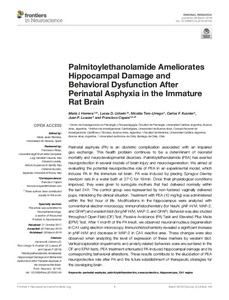Por favor, use este identificador para citar o enlazar este ítem:
https://repositorio.uca.edu.ar/handle/123456789/6220| Campo DC | Valor | Lengua/Idioma |
|---|---|---|
| dc.contributor.author | Herrera, María Inés | es |
| dc.contributor.author | Udovin, Lucas Daniel | es |
| dc.contributor.author | Toro-Urrego, Nicolás | es |
| dc.contributor.author | Kusnier, Carlos Federico | es |
| dc.contributor.author | Luaces, Juan P. | es |
| dc.contributor.author | Capani, Francisco | es |
| dc.date.accessioned | 2019-06-12T01:38:52Z | - |
| dc.date.available | 2019-06-12T01:38:52Z | - |
| dc.date.issued | 2018 | - |
| dc.identifier.citation | Herrera, M. I., Udovin, L. D., Toro-Urrego, N., Kusnier, C. F., Luaces, J. P., y Capani, F. (2018). Palmitoylethanolamide ameliorates hippocampal damage and behavioral dysfunction after perinatal asphyxia in the immature rat brain [en línea] Frontiers in Neuroscience, 12:145. Disponible en: https://repositorio.uca.edu.ar/handle/123456789/6220 | es |
| dc.identifier.issn | 1662-453X | - |
| dc.identifier.uri | https://repositorio.uca.edu.ar/handle/123456789/6220 | - |
| dc.description.abstract | Abstract: Perinatal asphyxia (PA) is an obstetric complication associated with an impaired gas exchange. This health problem continues to be a determinant of neonatal mortality and neurodevelopmental disorders. Palmitoylethanolamide (PEA) has exerted neuroprotection in several models of brain injury and neurodegeneration. We aimed at evaluating the potential neuroprotective role of PEA in an experimental model, which induces PA in the immature rat brain. PA was induced by placing Sprague Dawley newborn rats in a water bath at 37°C for 19 min. Once their physiological conditions improved, they were given to surrogate mothers that had delivered normally within the last 24 h. The control group was represented by non-fostered vaginally delivered pups, mimicking the clinical situation. Treatment with PEA (10 mg/kg) was administered within the first hour of life. Modifications in the hippocampus were analyzed with conventional electron microscopy, immunohistochemistry (for NeuN, pNF-H/M, MAP-2, and GFAP) and western blot (for pNF H/M, MAP-2, and GFAP). Behavior was also studied throughout Open Field (OF) Test, Passive Avoidance (PA) Task and Elevated Plus Maze (EPM) Test. After 1 month of the PA insult, we observed neuronal nucleus degeneration in CA1 using electron microscopy. Immunohistochemistry revealed a significant increase in pNF-H/M and decrease in MAP-2 in CA1 reactive area. These changes were also observed when analyzing the level of expression of these markers by western blot. Vertical exploration impairments and anxiety-related behaviors were encountered in the OF and EPM tests. PEA treatment attenuated PA-induced hippocampal damage and its corresponding behavioral alterations. These results contribute to the elucidation of PEA neuroprotective role after PA and the future establishment of therapeutic strategies for the developing brain. | es |
| dc.format | application/pdf | es |
| dc.language.iso | eng | es |
| dc.publisher | Frontiers Media | es |
| dc.rights | Acceso Abierto | es |
| dc.rights.uri | https://creativecommons.org/licenses/by-nc-sa/4.0/ | es |
| dc.source | Frontiers in Neuroscience, 12:145, 2018 | es |
| dc.subject | COMPORTAMIENTO | es |
| dc.subject | ASFIXIA PRENATAL | es |
| dc.subject | NEUROPSICOLOGIA | es |
| dc.subject | TRASTORNOS DEL NEURODESARROLLO | es |
| dc.title | Palmitoylethanolamide ameliorates hippocampal damage and behavioral dysfunction after perinatal asphyxia in the immature rat brain | es |
| dc.type | Artículo | es |
| uca.path | Facultad de Psicología y Psicopedagogía|Artículos | es |
| uca.disciplina | PSICOLOGIA | es |
| uca.filename | /home/data-uca-generic/folder_generic_common/articulos/palmitoylethanolamide-ameliorates-hippocampal-damage/metadata.xml | es |
| uca.issnrd | 1 | es |
| uca.affiliation | Fil: Herrera, María I. Universidad Católica Argentina. Facultad de Psicología y Psicopedagogía. Centro de Investigaciones en Psicología y Psicopedagogía; Argentina | es |
| uca.affiliation | Fil: Udovin, Lucas Daniel. Universidad de Buenos Aires. Instituto de Investigaciones Cardiológicas; Argentina | es |
| uca.affiliation | Fil: Udovin, Lucas Daniel. Consejo Nacional de Investigaciones Científicas y Técnicas; Argentina | es |
| uca.affiliation | Fil: Toro-Urrego, Nicolás. Universidad de Buenos Aires. Instituto de Investigaciones Cardiológicas; Argentina | es |
| uca.affiliation | Fil: Toro-Urrego, Nicolás. Consejo Nacional de Investigaciones Científicas y Técnicas; Argentina | es |
| uca.affiliation | Fil: Kusnier, Carlos. Universidad de Buenos Aires. Instituto de Investigaciones Cardiológicas; Argentina | es |
| uca.affiliation | Fil: Kusnier, Carlos. Consejo Nacional de Investigaciones Científicas y Técnicas; Argentina | es |
| uca.affiliation | Fil: Luaces, Juan P. Universidad de Buenos Aires. Instituto de Investigaciones Cardiológicas; Argentina | es |
| uca.affiliation | Fil: Luaces, Juan P. Consejo Nacional de Investigaciones Científicas y Técnicas; Argentina | es |
| uca.affiliation | Fil: Capani, Francisco. Universidad de Buenos Aires. Instituto de Investigaciones Cardiológicas; Argentina | es |
| uca.affiliation | Fil: Capani, Francisco. Consejo Nacional de Investigaciones Científicas y Técnicas; Argentina | es |
| uca.affiliation | Fil: Capani, Francisco. Universidad Católica Argentina. Facultad de Medicina; Argentina | es |
| uca.affiliation | Fil: Capani, Francisco. Universidad Autónoma de Chile; Chile | es |
| uca.orden | ISSN 1662-453X | es |
| uca.version | publishedVersion | es |
| item.grantfulltext | open | - |
| item.languageiso639-1 | en | - |
| item.fulltext | With Fulltext | - |
| crisitem.author.dept | Facultad de Psicología y Psicopedagogía | - |
| crisitem.author.dept | Centro de Investigaciones en Psicología y Psicopedagogía (CIPP) | - |
| crisitem.author.dept | Consejo Nacional de Investigaciones Científicas y Técnicas | - |
| crisitem.author.dept | Instituto de Investigaciones Cardiológicas | - |
| crisitem.author.orcid | 0000-0003-0342-0628 | - |
| crisitem.author.parentorg | Pontificia Universidad Católica Argentina | - |
| crisitem.author.parentorg | Facultad de Psicología y Psicopedagogía | - |
| crisitem.author.parentorg | Consejo Nacional de Investigaciones Científicas y Técnicas | - |
| Aparece en las colecciones: | Artículos | |
Ficheros en este ítem:
| Fichero | Descripción | Tamaño | Formato | |
|---|---|---|---|---|
| fnins-12-00145.pdf | 2,13 MB | Adobe PDF |  Visualizar/Abrir |
Visualizaciones de página(s)
168
comprobado en 27-abr-2024
Descarga(s)
88
comprobado en 27-abr-2024
Google ScholarTM
Ver en Google Scholar
Este ítem está sujeto a una Licencia Creative Commons

